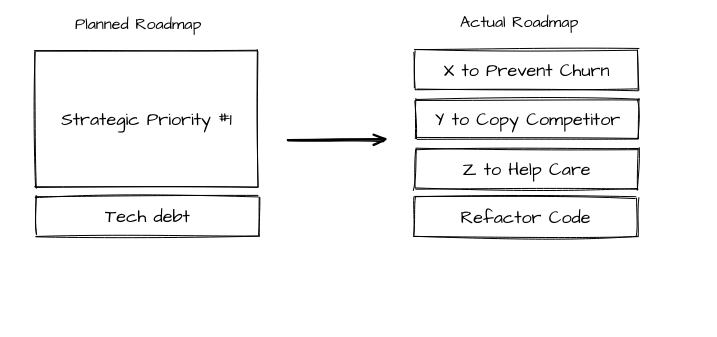The Biggest Threat Facing Product Orgs: Lack of a Strategic Roadmap
Are you a go-to-market leader frustrated with the lack of impact from new product features? Or a product manager spending the majority of your time enabling sales and marketing? You are not alone. Lack of a strategic product roadmap is the biggest threat facing product organizations right now. And we are all at fault.
To be clear, no one is doing this on purpose. Strategy is typically the headliner at annual offsites. And some businesses even successfully walk away with a crisp list of three to five strategic initiatives. In reality though, day-to-day business pressures constantly disrupt these plans.
For example, sales may demand a new feature to keep a large customer from churning, while marketing may urgently want to respond to a competitor's new feature announcement. Customer care may be receiving too many calls about a particular issue, and engineering may need to refactor. It can feel like the right thing to do is to respond to these needs, but doing so can lead to a lack of focus and direction.
Without a clear strategy, product roadmaps quickly lose focus in response to day-to-day business pressures.
Once the product strategy is created, you need to trust and respect the tough decisions the organization (hopefully) made and hold true to your strategy. The most important part of product strategy is focus. Focus inherently means that you are saying “no” to way more things than you are saying “yes” to.
Of course this does not allow you to put blinders on to what is going on in the business and broader market. But far too often we abandon our strategy and become reactive in our day-to-day operations. The result? Lackluster products that don’t meet the needs of customers and frustrated teams that aren’t making any progress.
How do we combat this?
Think strategically. Make the tough tradeoff decisions and stick to them. All projects on the roadmap should be aligned with these declared strategic priorities, with few exceptions.
Align incentives. Product development teams should be incentivized based on outcomes, rather than on the number of Jira tickets completed and features shipped. If teams are measured based on driving a specific outcome, they will be more likely to scrutinize potential disruptions to product strategy.
Ensure teams feel heard. The goal is not to shut down communication channels between cross-functional teams. Instead, it’s to ensure understanding of the product strategy and empowerment to deprioritize requests that do not align with the strategy. The product team is still responsible for sharing what they are working on, why it's important, and having a closed feedback loop with go-to-market teams.
Repeat the strategy often. Don’t assume that the team remembers the strategy that was set at the beginning of the year, or even quarter. Frequently reiterate the declared strategy and its importance to the business. This will allow your teams to help reinforce that strategy with every decision they make.
Without a clear product strategy and aligned incentives, products can become random collections of features that do not resonate with customers. To achieve long-term success, it's essential to not only craft your product strategy, but to stick to it.

